To say that the 2017–18 season was a rough one for Southampton would be putting it mildly. An intriguing managerial hire in Mauricio Pellegrino and the smart acquisition of Mario Lemina suggested a decent, if perhaps unspectacular, season. Instead, they had an even harder time scoring goals last season with only 22 goals coming from open play, a paltry return. All of that led to the eventual dismissal of Pellegrino in favor of Mark Hughes, who helped steer the club away from relegation by the end of the season.
So here we are this season, the first since perhaps 2014–15 where the expectations from the general public isn’t for Southampton to compete for a Europa League position. They’ve surprisingly kept hold of Lemina and most of their other core pieces, and have once again spent ample amounts of money in the hope of having a strong squad. On the other hand they handed Mark Hughes, a manager you much rather try and help you steer clear of relegation than build a competitive team, a three year contract.
Metrics
After years of consistency, 2017–18 was the first season where there was a real downturn in Southampton’s numbers. Over the past four seasons, despite the fact that Southampton had three different managers, they always had greater than a 50% share in both traditional shot metrics and expected goal models. For 2017–18, those numbers dipped into the 46–48% range. To put it another way, Southampton went from a team that performed at around the talent level of a Europa League side to one that performed like a middling PL side, which is not a great sign.
The only saving grace for Southampton last season was that hiring Mark Hughes gave them just enough of a managerial boost that they survived relegation, even though you can pick apart at the boost by pointing out that they only took 8 points out of the 8 matches while he was manager. In particular, what was eye opening was that the way Southampton stabilized under Mark Hughes in the short term was in a manner that is just about the antithesis of what Southampton and their fans have wanted the team to play over the years, even more so than what happened under Claude Puel when he got criticized for the style of play. Their play wasn’t easy on the high in the least and resulted in the club having to grind out results through low event matches.
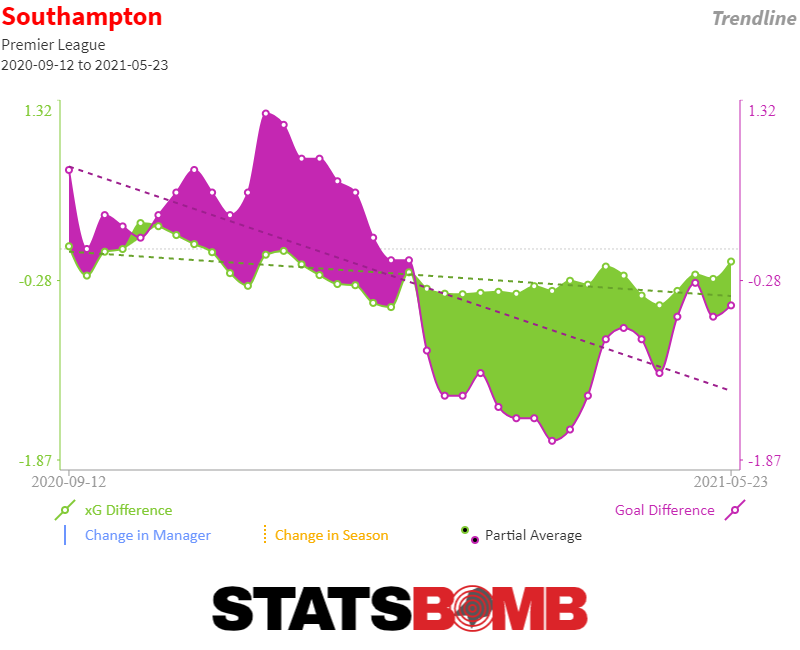
Style of Play
One of the big theme under Mark Hughes was that Southampton had a hard time creating attacks during possession because their spacing was all over the place. Sometimes they would have too many players occupying midfield areas and no one helping connect the play up to the attack. This was especially prevalent when Mario Lemina wasn't playing, as he was more active in trying to get in between the opposition midfield and defense. In the final third, Southampton’s poor spacing came from constantly having no support for the man on the ball in wide areas. Southampton ranked in the top five in percentage of penalty box entries coming from crosses, and in the bottom five in cross completion %. They constantly depended on low quality crosses delivered without any flow or rhythm. When they weren’t crossing the ball, often you’d find a Southampton player in the wide areas with no one to support him in the half space. There would just be acres of space untended, and it would lead to them having to recycle the ball back and look for something else.
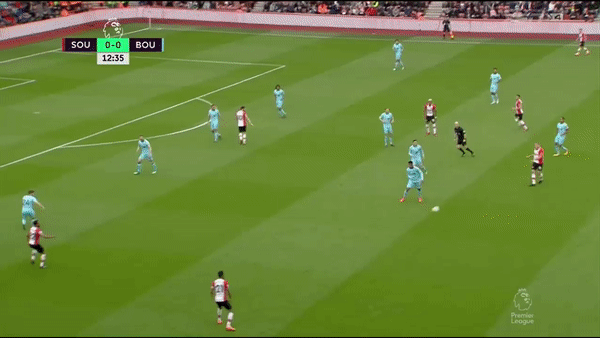
One thing Southampton did do well during possession was experiment with using Nathan Redmond in a role similar to how Leicester used Riyad Mahrez last season, an attacking wide player who’s positioned as a pseudo midfielder. Redmond has decent close control in tight space and an ability to create chances for others, and while he hasn’t turned into something more than a league average attacker, perhaps at a better team with some structure in attack he’d be more at home. It’s little sequences like this that hint at him still having room to grow into a good player.
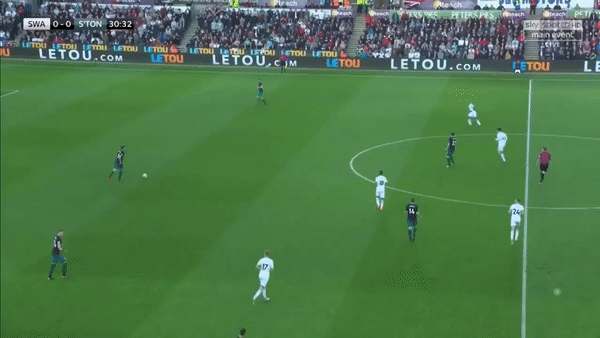
Southampton’s overall attack ranked in the bottom half of the league under Mark Hughes, which isn’t good. What they did do well to make up a little bit for their deficiencies in possession was creating transition opportunities off of their low block. Their midfield had the collective passing ability to make that first pass that got the ball up to the likes of Dusan Tadic and Redmond so they could run at defenses.
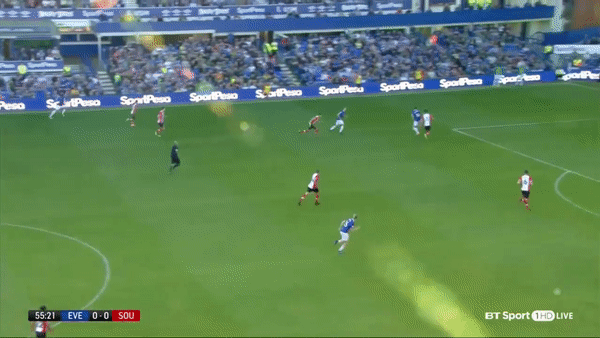
For all the ills about Southampton's attack, what helped them maintain their Premier League status was that they performed rather well defensively. They were a team that were fine with giving up possession, even up until the halfway line and allowing the opposition backline to have the ball. They functioned as a team that would soak up as much pressure as possible in the hopes of reducing their opponent shot quality on average, sort of like an imitation of Burnley. Despite the high volume of shots, Southampton gave up an xG/shot of just under 9% from open play, which is a number you would gladly take in a trade off for not being a shot suppression side.
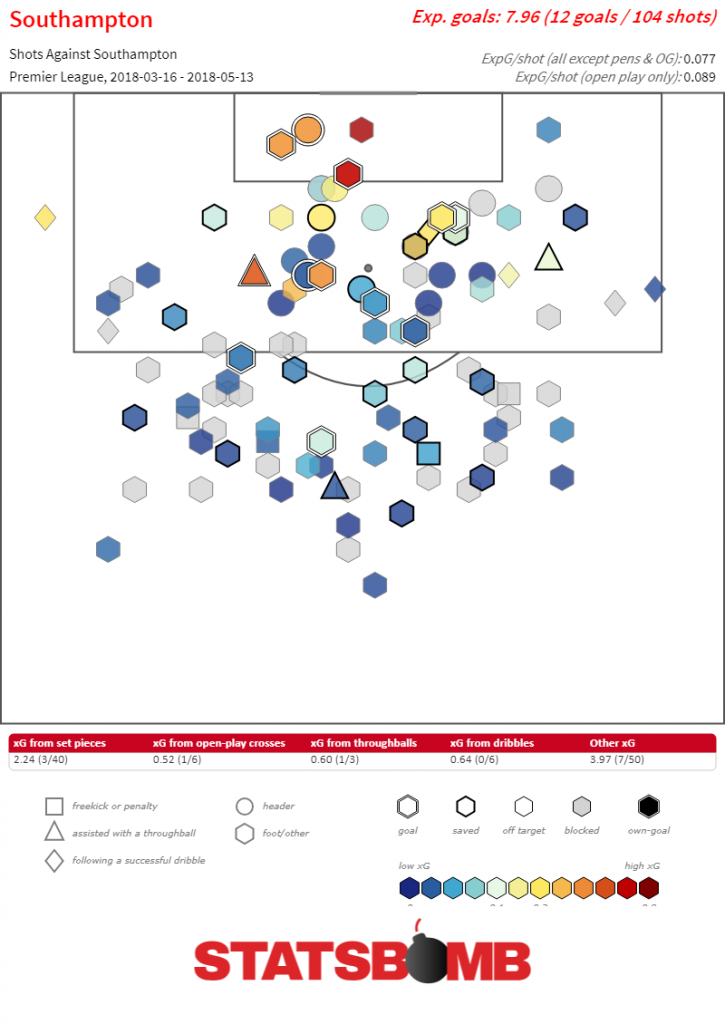
When Southampton were aggressive, it was in their own defensive third through trying to have a numbers advantage off the ball. They weren’t terribly concerned with trying to win the ball back in the opponent’s half, rather they were more content with just retreating back into their own half and setting up shop because they weren’t all that effective in winning the ball higher up the pitch. When the ball was lost in their own third, that was when you would see a greater urgency to regain possession. In the eight games under Mark Hughes, no team in the Premier League underwent more defensive actions in their own third, a stark cry from what happened under Mauricio Pellegrino when they were below league average.
Personnel + Transfers
For years, Southampton were a model club. They turned themselves into a top eight Premier League side in an incredibly quick time span. They were the club who found gems in Scotland (Virgil Van Dijk), Holland (Tadic) and Austria (Sadio Mane). They were the club that consistently outperformed what their wage bill would dictate and sold their key players at just around their peak value. Southampton weren’t perfect, but they largely ran their front office in a sensible manner, which is about all you could ask for from a club that doesn't have the resources to be part of the elite.
That’s not been the case over the past couple of years as Southampton’s hit rate on transfers has been on the decline. In particular, The 2016 summer window may have turned out to be something of a seminal moment for Southampton as they had three opportunities at finding high upside talent with Pierre-Emile Höjbjerg, Sofiane Boufal, and Redmond. All three of these moves were reasonable at the time, but in retrospect they haven’t come close to hitting a home run with any of those moves. Höjbjerg to this point has been around a league average midfielder, which given his fee makes it a fine enough move. Boufal and Redmond were attempts at trying to replicate the value that they got from Mane, but those have been misses to varying degrees. Boufal was someone whose talent was apparent at Lille but who now looks like a poor transfer, which is a major problem considering he’s one of the most expensive transfers in Southampton history. Redmond is someone who still intrigues but at age 24 he's more of an acquired taste than a dependable attacking stud.
Given their struggles in the 2016 summer window, along with the awful panic buy of Guido Carillo, that’s helped create a squad that has no one who tilts the scales in their favor, especially in the attacking end where they just have no dependable outlet. Maybe that changes with some of the players they acquired this window, with Jannik Vestergaard being an accomplished defender at Borussia Mönchengladbach and Mohamed Elyounoussi being another attempt at finding a young wide player who fills the void left by Mane. The only major player who left on a permanent deal was Tadic going to Ajax. At his apex from 2014–16, Tadic was one of the better players in the league but his performance declined noticeably the last two seasons. Maybe it’s age related decline or just not fitting well with previous managers, but he was still their best playmaker and someone who had a good awareness of connecting play during possession via his off-ball movement, and to this point they haven’t really gone and replaced him with someone else.
2018–19 Outlook
Even with the jumbled mess that has become the Premier League below the top six, it’s hard to come up with an argument that Southampton are going to be good for 2018–19. The grind it out football Southampton played in those final eight games probably isn't sustainable through an entire season, in part because teams managed by Mark Hughes previously haven't maintained this level of defensive solidity, and, generic as this may sound, it's genuinely a struggle to see where the goals will come from.
Given Southampton don’t have the greatest squad out there, this is where having a manager who could outperform Southampton’s current squad talent would come in handy but instead of betting on themselves to once again find that person, they settled on keeping Hughes on a three year contract. Hughes got a lot of goodwill from transitioning Stoke from a team that wasn’t fun to watch at the slightest to one that had a little bit more charm during open play, but outside of 2014–15, his Stoke teams routinely got dominated on the shot count in part because they were bad at generating shots. That was bad enough a few years ago, but given the influx of managerial talent at both the top and bottom ends of the table, it stands to reason that Hughes would rank well towards the bottom of the table in terms of coaching talents.
Southampton and their fans should brace themselves for another difficult year. Between the shaky marriage of squad talent and coaching, and deadwood clubs like Swansea, Stoke, West Brom getting replaced by Fulham and Wolves that are both stronger than average promoted sides, it wouldn’t be surprising if Southampton are barely holding their head above water by the time we hit the homestretch of the season.
Thank you for reading. More information about StatsBomb, and the rest of our season previews can be found here.